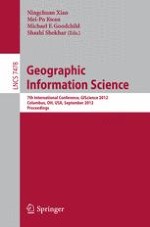2012 | OriginalPaper | Chapter
Crowdsourcing Satellite Imagery Analysis: Study of Parallel and Iterative Models
Authors : Nicolas Maisonneuve, Bastien Chopard
Published in: Geographic Information Science
Publisher: Springer Berlin Heidelberg
Activate our intelligent search to find suitable subject content or patents.
Select sections of text to find matching patents with Artificial Intelligence. powered by
Select sections of text to find additional relevant content using AI-assisted search. powered by
In this paper we investigate how a crowdsourcing approach i.e. the involvement of non-experts, could support the effort of experts to analyze satellite imagery e.g. geo-referencing objects. An underlying challenge in crowdsourcing and especially volunteered geographical information (VGI) is the strategy used to allocate the volunteers in order to optimize a set of criteria, especially the quality of data. We study two main strategies of organization: the parallel and iterative models. In the parallel model, a set of volunteers performs independently the same task and an aggregation function is used to generate a collective output. In the iterative model, a chain of volunteers improves the work of previous workers. We first study their qualitative differences. We then introduce the use of Mechanical Turk Service as a simulator in VGI to benchmark both models. We ask volunteers to identify buildings on three maps and investigate the relationship between the amount of non-trained volunteers and the accuracy and consistency of the result. For the parallel model we propose a new clustering algorithm called
democratic clustering algorithm
DCA taking into account spatial and democratic constraints to form clusters. While both strategies are sensitive to their parameters and implementations we find that parallel model tends to reduce type I errors (less false identification) by filtering only consensual results, while the iterative model tends to reduce type II errors (better completeness) and outperforms the parallel model for difficult/complex areas thanks to knowledge accumulation. However in terms of consistency the parallel model is better than the iterative one. Secondly, the Linus’ law studied for OpenStreetMap [7] (iterative model) is of limited validity for the parallel model: after a given threshold, adding more volunteers does not change the consensual output. As side analysis, we also investigate the use of the spatial inter-agreement as indicator of the intrinsic difficulty to analyse an area.
